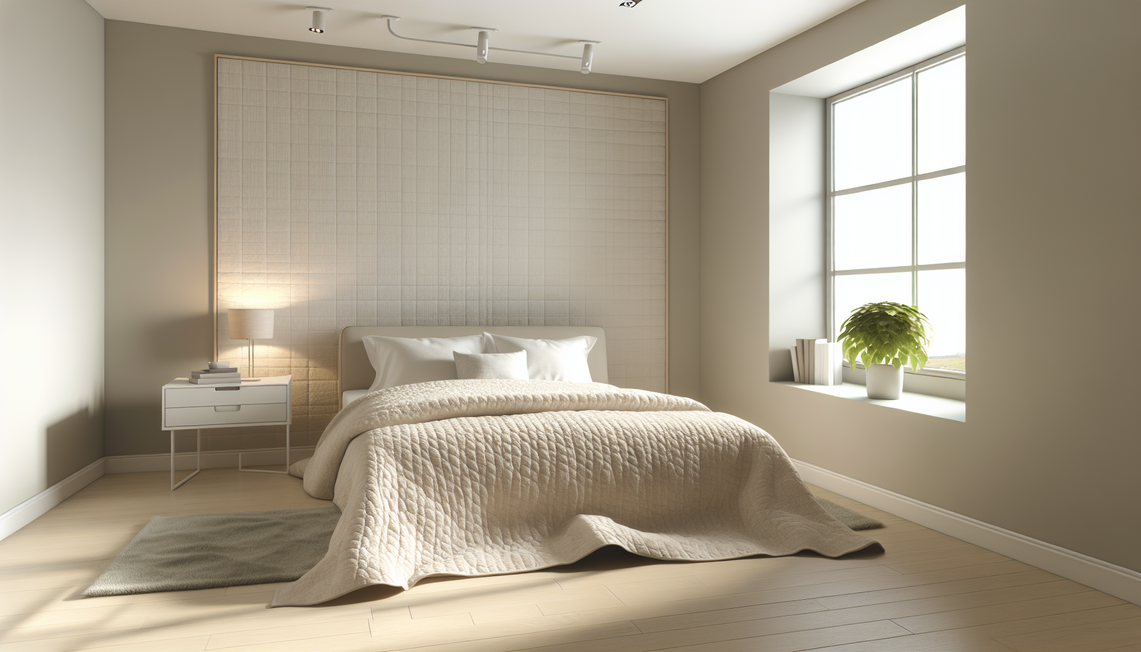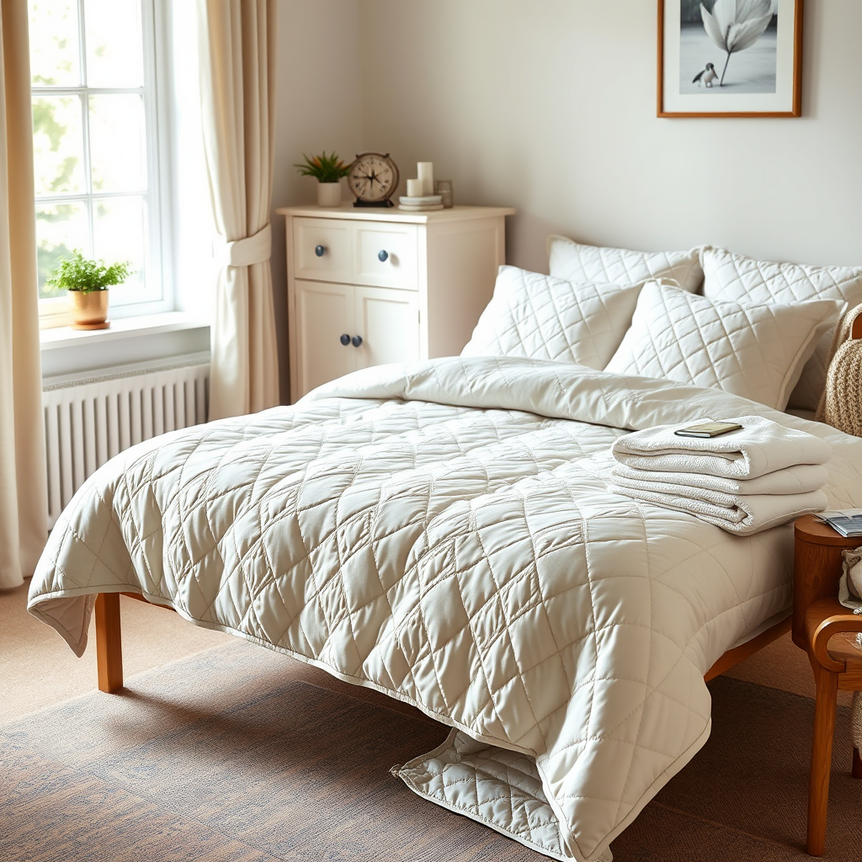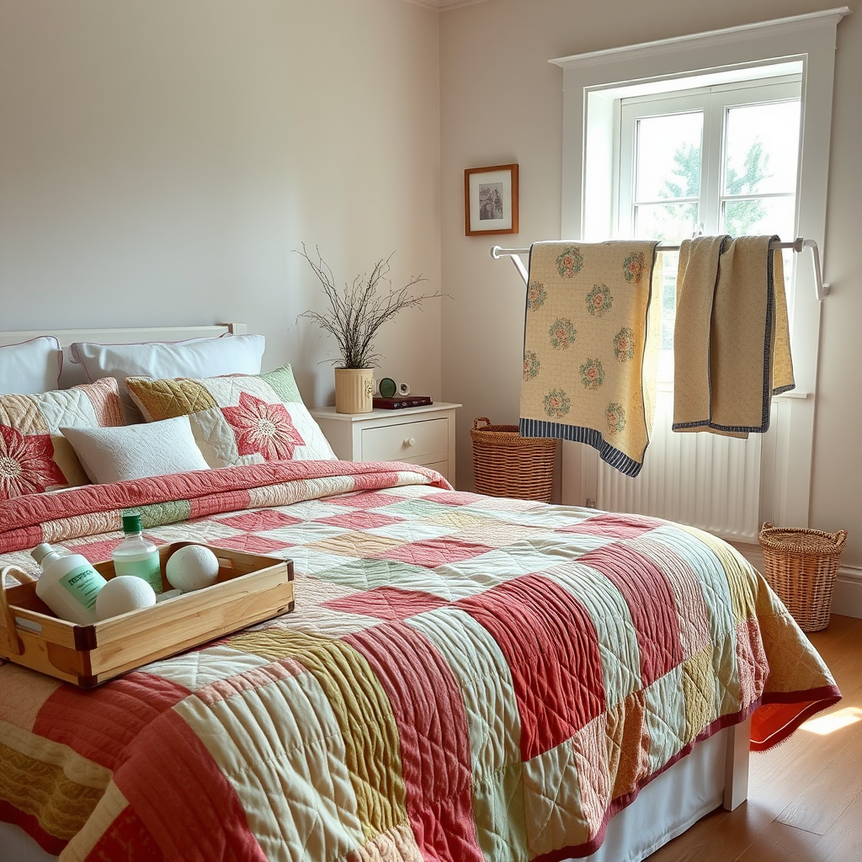For individuals in the UK dealing with allergies, selecting the right bedding is not merely a comfort choice but a critical step towards creating a healthier living environment. Common allergens like dust mites, mould spores, and pet dander can significantly impact sleep quality and overall well-being, leading to bothersome symptoms such as sneezing, nasal congestion, itchy eyes, and even exacerbating conditions like asthma. This is where hypoallergenic quilt bedspreads become indispensable.
Unlike conventional bedding that can inadvertently become a breeding ground for these microscopic irritants, hypoallergenic options are meticulously designed to minimise allergen accumulation. They employ specific materials and construction techniques that create a formidable barrier against these triggers, offering a much-needed respite for allergy sufferers. By covering your mattress and existing bedding layers, a quality hypoallergenic quilt bedspread acts as a protective shield, effectively reducing the number of airborne allergens and limiting direct skin contact with irritants. This strategic choice not only alleviates uncomfortable symptoms but also fundamentally improves the quality of your sleep, allowing you to wake up feeling more refreshed and less burdened by allergic reactions.
Key Characteristics That Define Truly Hypoallergenic Quilt Bedspreads
When you’re searching for a truly effective hypoallergenic quilt bedspread, understanding the defining features is paramount. These characteristics ensure the bedding actively works to protect you from allergens and provides lasting comfort.
Material Composition for Allergen Resistance
The foundation of any good hypoallergenic quilt bedspread lies in its material. Natural fibres are generally superior due to their inherent properties that resist dust mites and mould, while also being gentle on sensitive skin.
- Bamboo: Highly praised for its natural antibacterial and antifungal properties, bamboo actively inhibits the growth of dust mites and mould. It’s also exceptionally breathable and moisture-wicking, helping to create a dry sleep environment where allergens struggle to thrive. Its smooth fibres are also less likely to irritate sensitive skin.
- Organic Cotton: A soft, natural, and breathable choice, organic cotton is grown without harmful pesticides or synthetic fertilisers, making it a safer option for allergy sufferers who are also sensitive to chemicals. Look for OEKO-TEX® certified organic cotton, ensuring it’s free from a wide range of harmful substances. Its breathability helps regulate temperature and reduce moisture.
- Tencel™: Derived from sustainably sourced wood pulp, Tencel (a brand name for lyocell and modal fibres) is renowned for its exceptional breathability, moisture-wicking capabilities, and silky texture. Its smooth fibre surface and efficient moisture management make it very inhospitable to dust mites and bacteria, while also being incredibly gentle on the skin.
- Synthetic Blends (with caution): While some synthetic blends might be marketed as hypoallergenic due to their ease of washing, many lack the natural breathability and moisture-wicking properties of natural fibres. They can sometimes trap moisture, potentially leading to mould growth, and may contain chemicals or flame retardants that can irritate sensitive individuals. Always check for certifications if considering synthetics.
Tight Weave Construction: The Physical Barrier
Beyond the material itself, the way the fabric is woven is crucial. A densely, tightly woven fabric creates a physical barrier that dust mites and other microscopic allergen particles simply cannot penetrate. This prevents them from settling into the bedspread’s fibres and reaching you. Look for thread counts of 200 or higher for cotton, and dense weaves for bamboo and Tencel.
Certifications: Your Guarantee of Purity and Efficacy
Reputable certifications provide an independent assurance that a product meets specific standards for health and safety. Always look for these seals:
- OEKO-TEX® Standard 100: This global standard certifies that every component of the textile, from the fabric to the thread and accessories, has been tested for harmful substances and is therefore harmless for human health. It’s especially important for direct skin contact items like bedspreads.
- Global Organic Textile Standard (GOTS): For organic cotton, GOTS is the world’s leading processing standard for textile fibres made from organic materials. It ensures environmental and social criteria are met throughout the supply chain, from harvesting the raw materials to environmentally and socially responsible manufacturing and labelling.
- Allergy UK Seal of Approval: Products carrying this seal have been scientifically tested by Allergy UK’s panel of experts and proven to reduce or remove allergens from the environment. This is a highly reliable indicator for allergy sufferers in the UK.
Moisture-Wicking Properties: Combating Dampness
Dust mites and mould thrive in damp, humid environments. Hypoallergenic quilt bedspreads made from moisture-wicking fabrics actively draw moisture away from your body, preventing humidity build-up within the bedding layers. This helps maintain a drier sleeping environment, significantly inhibiting the growth and proliferation of both mould and dust mites.
Ease of Cleaning: Essential for Allergen Removal
Even the most advanced hypoallergenic materials require regular cleaning to remove accumulated allergens. Machine-washable bedspreads that can withstand frequent washing at high temperatures (ideally 60°C or higher, where fabric permits) are absolutely essential. This high heat is crucial for effectively killing dust mites and washing away their allergens, as well as pollen, pet dander, and other irritants, ensuring your bedspread remains fresh and truly hypoallergenic over time.
Comparison of Popular Hypoallergenic Materials for Quilt Bedspreads
Choosing the right material is key for comfort and allergen control. Here’s a comparison to help you decide:
| Material | Pros | Cons | UK Climate Suitability |
|---|---|---|---|
| Bamboo | Naturally antibacterial, highly breathable, excellent moisture-wicking, smooth and soft feel | May be pricier than cotton, can be prone to wrinkling, requires gentle washing to maintain integrity | Excellent for variable UK seasons; keeps you cool in summer and provides warmth in winter due to breathability |
| Organic Cotton | Soft, natural, durable, widely available, OEKO-TEX® certified options common, good breathability | May wrinkle easily, slower drying than synthetics, less moisture-wicking than bamboo/Tencel | Well-suited for UK’s mild to cool climate; comfortable year-round, especially good for those who prefer a traditional feel |
| Tencel™ | Sustainable, exceptionally smooth and silky texture, superior moisture management, highly resistant to dust mites and bacteria | Generally more expensive, limited colour and pattern options compared to cotton, requires specific care | Works exceptionally well during humid and dry UK periods; excellent temperature regulation for consistent comfort |
| Synthetic Blends (e.g., Polyester microfibre) | Usually durable, highly affordable, often quick-drying | Less breathable, may trap heat and moisture leading to potential mould growth, can feel less luxurious, may contain irritants for sensitive skin | Less ideal for allergic individuals due to potential for moisture trapping and reduced breathability, though some modern blends are improving |
Essential Buying Tips Tailored to UK Consumers with Allergies
Navigating the market for hypoallergenic bedding can be daunting, but these targeted tips will help UK consumers make an informed choice.
Identify Your Allergy Triggers
Before you even start shopping, it’s crucial to understand what specifically triggers your allergies. Are you primarily sensitive to dust mites, mould, pet dander, or perhaps even certain chemicals or fragrances? Knowing your primary triggers will guide your material and product choices. For example, if dust mites are your main concern, focus on tightly woven fabrics and materials known for their inhospitable environment to these pests. If chemical sensitivities are an issue, prioritise OEKO-TEX® certified organic options.
Select the Correct UK Bed Size
Ensuring your quilt bedspread fits snugly is not just about aesthetics; it’s vital for allergen control. A bedspread that is too small leaves gaps where allergens can accumulate and air circulation patterns can draw them into your breathing space. UK bed sizes typically include Single, Double, King, and Super King. Always check the dimensions of the bedspread against your mattress to ensure a perfect, encompassing fit that minimises exposed areas.
Seasonal Adaptability for UK Weather
The UK climate is renowned for its variability, often experiencing four seasons in one day! Choose materials that offer a good balance of warmth and breathability to ensure year-round comfort. For instance, while Tencel offers excellent cooling properties for humid summers, its moisture-wicking nature also makes it comfortable during cooler nights. Organic cotton provides reliable warmth without overheating, making it a versatile choice for most of the year. Consider having a lighter quilt for summer and a slightly heavier one for winter, both with hypoallergenic properties, to adapt to the fluctuations.
Read Care Labels Thoroughly
The care instructions on your quilt bedspread are not suggestions; they are critical for maintaining its hypoallergenic qualities and longevity. Proper washing at the recommended temperature (often 60°C for effective dust mite eradication) and drying cycles are essential for removing allergens and preventing mould. Ignoring these instructions can compromise the fabric’s integrity and its ability to resist allergens over time.
Avoid Chemical Treatments and Fragrances
Many conventional bedding products are treated with harsh chemicals for stain resistance, wrinkle-free properties, or even synthetic fragrances. For allergy sufferers, these additives can be significant irritants, leading to skin rashes, respiratory issues, or headaches. Always opt for bedding that explicitly states it is free from chemical treatments, dyes, and artificial fragrances. Look for certifications like OEKO-TEX® Standard 100 which guarantee the absence of harmful substances.
Proper Care and Maintenance to Maximise Your Hypoallergenic Quilt Bedspread’s Lifespan and Efficacy
Investing in a hypoallergenic quilt bedspread is just the first step. Proper and consistent care is crucial to maintaining its allergen-fighting properties and extending its lifespan.
Washing Frequency: The Key to Allergen Removal
To effectively manage allergens, especially dust mites, it is recommended to wash your quilt bedspread at least every 2 to 4 weeks. Dust mites thrive on dead skin cells, and frequent washing helps to remove their food source, along with pollen, pet dander, and other environmental allergens that accumulate over time. Always use a mild, allergen-free detergent to avoid adding new irritants to your bedding.
Drying: Preventing Mould and Mite Proliferation
After washing, it is absolutely essential to fully dry your bedspread as quickly as possible. Dampness is the perfect breeding ground for mould spores and allows dust mites to flourish. Whenever possible, tumble dry on a low heat setting until completely dry, or if air-drying, ensure it is in a well-ventilated area, ideally in sunlight, which has natural antimicrobial properties. Never put a damp bedspread back on your bed.
Seasonal Rotation: Maintaining Freshness and Fabric Integrity
If you have different quilt bedspreads for summer and winter, rotating them seasonally not only helps to manage temperature comfort but also gives each bedspread a period of rest, extending its fabric integrity and overall freshness. Before storing, ensure the bedspread is thoroughly cleaned and completely dry, then store it in a breathable bag to prevent dust and moisture accumulation.
UK-Specific Considerations: Addressing Hard Water
Many areas in the UK have hard water, which contains high levels of minerals. These minerals can leave residue on fabrics, potentially making them feel rougher and attracting more dust over time, thereby degrading the hypoallergenic properties. If you live in a hard water area, consider using a water softener, a specific detergent designed for hard water, or adding a small amount of white vinegar to the rinse cycle (check manufacturer’s instructions first) to minimise mineral build-up and keep your bedspread soft and effective.
Building a Fully Hypoallergenic Bedroom Environment for Lasting Relief
While a hypoallergenic quilt bedspread is a cornerstone, maximising allergy relief requires a holistic approach to your bedroom environment. Implementing these practices creates a comprehensive allergen-reduced sanctuary:
- Invest in Dust Mite-Proof Mattress and Pillow Encasements: These zippered covers create an impenetrable barrier around your mattress and pillows, trapping dust mites and their allergens inside and preventing new ones from colonising. Look for tightly woven fabrics that are specifically designed for allergen protection.
- Maintain Bedroom Humidity Below 50%: Dust mites thrive in humidity. Use a dehumidifier, especially during damp periods, or ensure adequate ventilation by opening windows daily for short periods. A hygrometer can help you monitor humidity levels accurately.
- Vacuum Floors and Upholstery Regularly with HEPA-Filter Vacuums: Standard vacuums can often stir up allergens. A vacuum cleaner equipped with a High-Efficiency Particulate Air (HEPA) filter captures microscopic particles like dust mite allergens, pet dander, and pollen, preventing them from being recirculated into the air. Vacuum at least once or twice a week.
- Declutter Surfaces to Prevent Dust Accumulation: Less clutter means fewer surfaces for dust and allergens to settle. Minimise decorative items, books, and knick-knacks, especially near your bed, to make cleaning easier and more effective.
- Ensure Adequate Ventilation by Opening Windows: Even in colder months, opening windows for 10-15 minutes daily can significantly improve air quality by reducing indoor pollutants, allergens, and humidity. Good airflow helps to disperse stagnant air and prevent mould growth.
- Wash Bedding Weekly: In addition to your bedspread, wash all other bedding components like sheets and pillowcases weekly at 60°C or higher to effectively kill dust mites and remove allergens.
- Consider Air Purifiers with HEPA Filters: An air purifier can complement your efforts by continuously filtering airborne allergens, especially beneficial for those with severe sensitivities.
Health Benefits and Where to Find Quality Hypoallergenic Quilt Bedspreads in the UK
Consistently using hypoallergenic quilt bedspreads, alongside other allergen-reduction strategies, offers profound health benefits. By significantly reducing exposure to common allergens, you directly support your respiratory health, helping to minimise the triggers that can lead to debilitating symptoms of asthma and allergic rhinitis. This proactive approach can translate into fewer allergy flare-ups, less reliance on antihistamines and decongestants, and potentially lower healthcare costs associated with managing chronic allergic conditions. Beyond symptom relief, the most significant benefit is the tangible improvement in sleep quality. When your sleep environment is free from irritants, you can enjoy deeper, more restorative rest, leading to enhanced daytime energy, improved concentration, and an overall boost in your quality of life.
For trusted, high-quality hypoallergenic quilt bedspreads in the UK, designed specifically to help allergy sufferers find comfort and peace of mind, explore the meticulously curated collection at Rugstars UK. Their expertly crafted, certified bedding options blend superior comfort with effective allergen control, making them an ideal choice for a healthier bedroom.
Frequently Asked Questions About Hypoallergenic Quilt Bedspreads
Here are some common questions to help you make an informed decision about hypoallergenic quilt bedspreads:
Q: What materials are safest for allergy sufferers?
A: Bamboo, Organic Cotton, and Tencel™ are top choices due to their natural allergen resistance, breathability, and moisture-wicking properties, which create an inhospitable environment for dust mites and mould.
Q: How often should hypoallergenic bedspreads be washed?
A: Ideally, you should aim to wash your hypoallergenic quilt bedspread at least every 2 to 4 weeks using mild, allergen-free detergents to effectively remove dust mites, pollen, pet dander, and other accumulated allergens.
Q: Can hypoallergenic bedding help with asthma?
A: Yes, absolutely. By significantly reducing your exposure to common indoor allergens like dust mites and pet dander, hypoallergenic bedding can help minimise triggers that often exacerbate asthma symptoms, leading to improved breathing and fewer attacks.
Q: Are all certifications equally reliable when buying hypoallergenic products?
A: While many labels exist, certifications like OEKO-TEX® Standard 100, Global Organic Textile Standard (GOTS), and especially the Allergy UK Seal of Approval are highly reliable indicators. They involve rigorous independent testing to ensure products meet strict standards for safety and efficacy in reducing allergens.
Q: How do I know if a quilt bedspread is truly hypoallergenic?
A: Look for key indicators: specific certifications (OEKO-TEX®, GOTS, Allergy UK Seal), a tight weave construction, natural moisture-wicking materials like bamboo or Tencel, clear labelling of hypoallergenic properties, and positive user reviews from other allergy sufferers. Reputable brands will be transparent about their product’s composition and testing.
Choosing the right hypoallergenic quilt bedspread is an effective and vital first step toward cultivating a healthier, allergen-reduced bedroom environment. For high-quality, allergy-friendly options that seamlessly blend comfort, sustainability, and aesthetic appeal, visit Rugstars UK and take control of your sleep health today.



